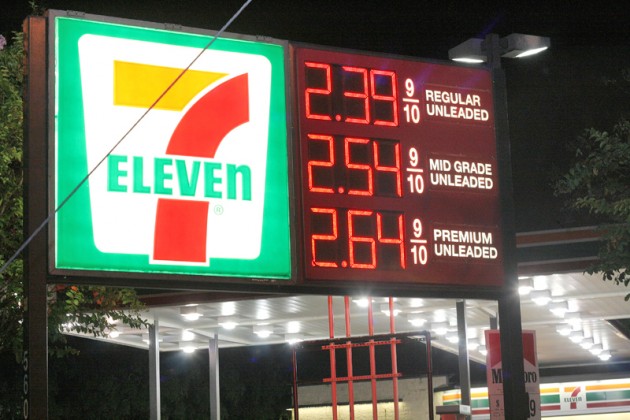Plunging gas prices about to slow down

Every morning, a few pennies peel off of gas stations’ signs. A nickel here, a dime there.
From Tuesday to Wednesday, the price of a gallon of regular gas at the Citgo station on Livingston and Bearss avenues dropped 17 cents, from $2.59 to $2.42. Though that number has since stabilized at $2.49, other Tampa Bay area stations have been posting prices as low as $2.35.
Compare that to three months ago, when AAA reported that the state’s average cost was $4 a gallon. That’s about $16 saved for every 10 gallons purchased.
Though AAA estimates this price decline will continue through December, AAA Auto Club South spokesman Gregg Laskoski said students shouldn’t expect such drastic drops to continue.
“I don’t think we’re going to see them drop four or five cents a day for much longer,” he said. “Soon, things will begin to stabilize and the drop will be measured in tenths of a cent, which is a normal decline.”
The fluctuation in gas prices can be attributed to many factors, Laskoski said, including the slump on Wall Street.
“Over the summer we saw a weakness in the American dollar, which led to speculative investment in the commodities market, particularly in crude oil,” he said.
During times of economic struggle, people may scale back in certain areas, but necessities — such as gas to get to work or school — will still be in demand. This demand sparked much of the interest in crude oil investments, and it also drove up gas prices, Laskoski said.
“Since July, the American dollar has been making some gains against the Euro and other forms of currency, and people are starting to invest elsewhere,” he said.
Though some say the dip in fuel costs has to do with Tuesday’s presidential election, USF political science professor and elections specialist Darryl Paulson said such claims are little more than urban legend.
“People always come up with theories to support their preconceived notions,” he said. “The fact that gas approached $4 a gallon shoots that theory to pieces. If the incumbent party wanted to lower gas prices to benefit the party’s candidate, it would have done it much sooner.”
The drop in prices, Paulson said, is really just an issue of supply and demand, influenced by the state of the economy.
The U.S. Department of Transportation reported that in the past 10 months, Americans have driven 78 billion miles less than they did during the same period last year. As drivers began restricting their time on the road, the same amount of gas poured into stations, resulting in excess supply that overwhelmed dwindling demand.
Because the demand for oil has dropped, so have the prices — as Laskoski said, however, the size of the declines may begin to shrink.
On Wednesday, the price of crude oil climbed more than $4 a barrel — its biggest gain in a month — following interest rate cuts by the Federal Reserve. China and Taiwan also reduced their rates, bloomberg.com reported.
For many students, plummeting gas prices make it easier to visit family and friends.
Art history graduate student Liz Tanski lives on campus, but her husband lives in Orlando. The cost of gas is a determining factor in how often she visits him, she said. She sees him about two or three weekends a month, but said she cannot afford to live in Orlando and commute to USF.
“The gas prices may be down, but everything else is going up,” she said.
Biomedical science major Winston Tsai drives to campus five days a week from Carrollwood, he said, and while the declines haven’t made much of a dent in the cost of his daily commute, they have made it more affordable for him to attend expos throughout the state, where he sells exotic reptiles.
“It’s a lot easier to travel to shows and make a profit now that gas doesn’t cost as much,” he said. “A lot of other vendors are more willing to go to farther away shows because of it.”
In January, gas prices will gradually start to climb again, Laskoski said, though likely in terms of tenths of cents. Gas supplies will be reduced during this time as refineries clear out their winter blend of gas and replace it with a summer blend.
Federal regulations require gas companies to provide a summer blend — which has certain additives that allow the fuel to burn cleaner, making it environmentally friendly — from May 1 to Sept. 30. The rest of the year, gas companies use a winter blend — which doesn’t include additives and is cheaper to produce — thus accounting for the slight reductions in gas prices every fall, Laskoski said.
“That helps bring gas costs down, but in the case this fall, many more factors were involved,” he said.







